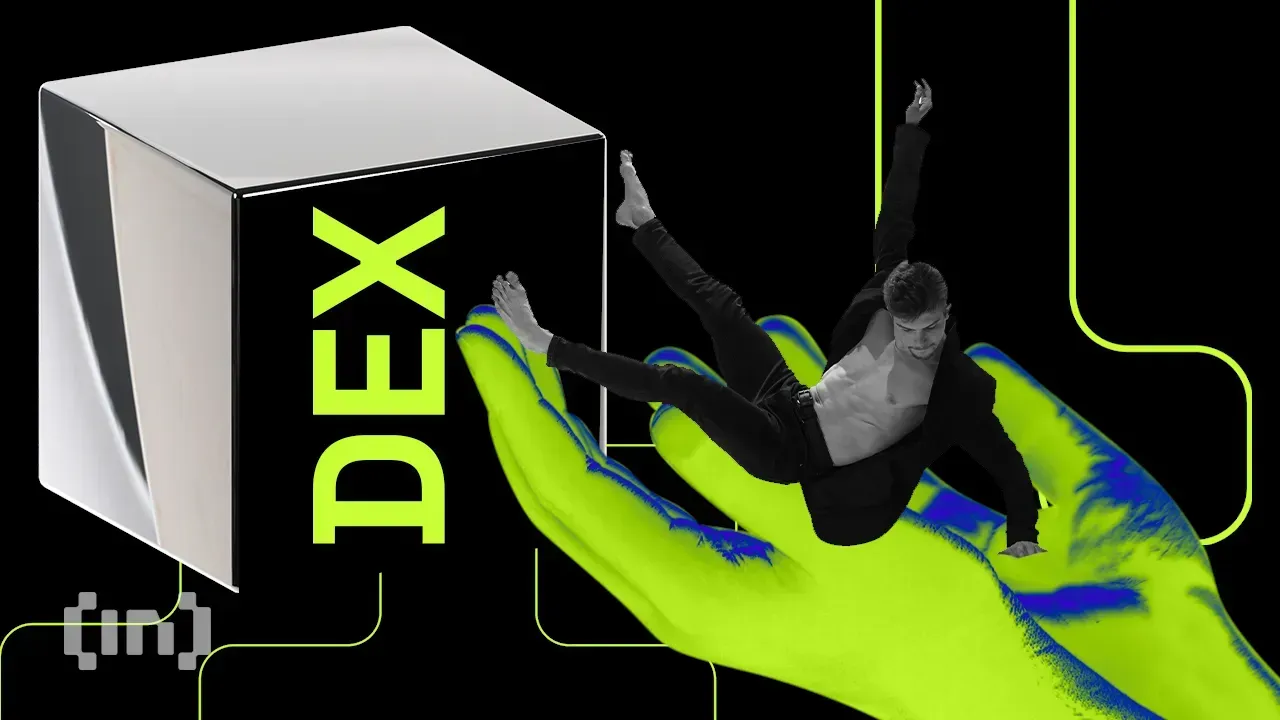Market
A Threat to Crypto’s Decentralized Future?
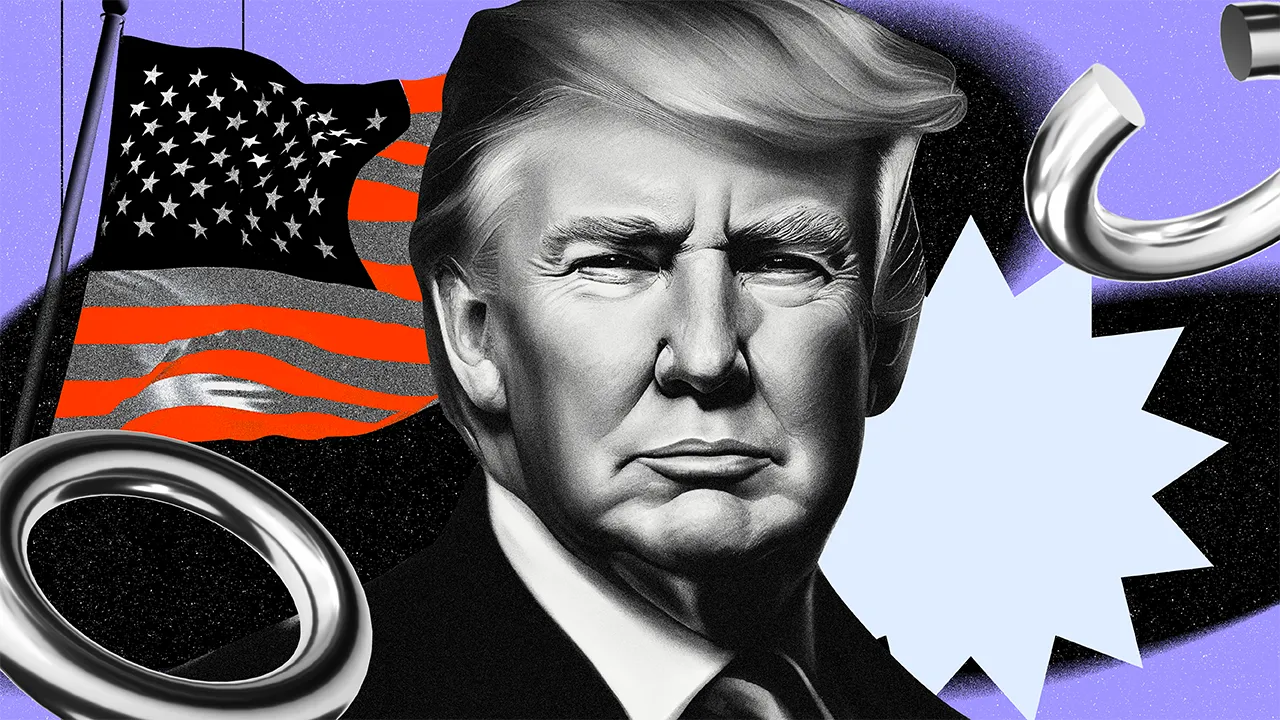
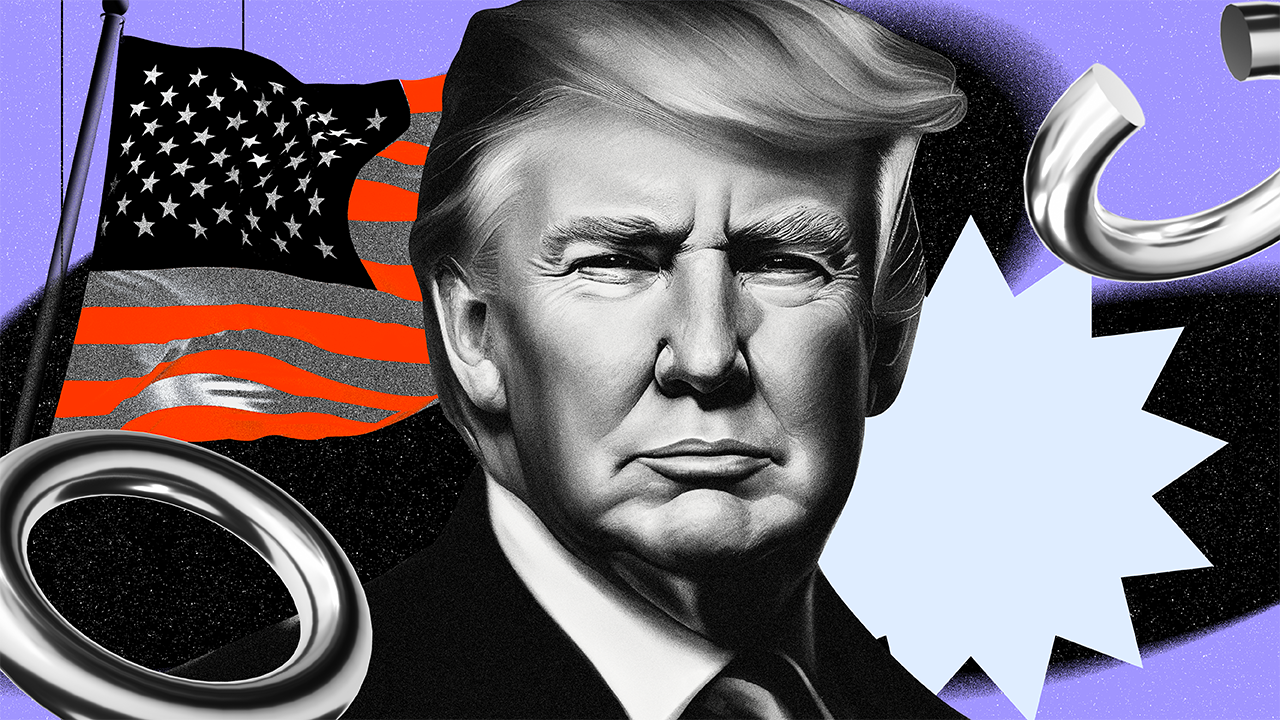
The Trump family has made headlines lately over potential ventures with Binance and the BNB Chain. Rumors started circulating that the Trump Organization is considering buying a stake in Binance’s US arm, while Trump recently launched his USD1 stablecoin on BNB Chain. This nature of the President’s involvement has raised concerns over decentralization.
BeInCrypto spoke with representatives from Galxe, Komodo Platform, Kronos Research, Yellow Network, and Solv Protocol to gather further insights on what Trump’s involvement could mean for the centralized exchange and the decentralized blockchain.
Initial Reactions to Trump’s Binance Ventures
A series of events in the last month seem to have brought US President Donald Trump and Binance founder Changpeng “CZ” Zhao closer together.
Just two weeks ago, reports circulated that the Trump family may be negotiating to acquire a stake in the US arm of the world’s largest crypto exchange. Then, on Tuesday, World Liberty Financial officially launched its very own stablecoin, known as USD1.
Though Binance’s actual involvement in the launch remains unclear, USD1 is native to the BNB Chain. Though BNB is decentralized, community members raised concerns that a stake in Binance could indirectly influence the blockchain’s greater ecosystem.
As a result, a vital question has erupted: Are these latest ventures good for market adoption and crypto’s reputation, or do they go against crypto’s decentralized and community-driven ethos?
Industry experts proved to be divided in their responses.
Does Trump Involvement Signal Market Growth?
Trump has completely changed the political landscape in the United States, creating a more favorable environment for cryptocurrency adoption. Given his endeavors in the industry, Trump’s approach has been particularly novel.
Announcements like the creation of World Liberty Financial and the launch of his meme coin were initially celebrated by the community for the increased visibility they gave to the crypto industry.
Now, with rumors of a potential stake acquisition in Binance and the launch of USD1 on the BNB Chain, some expect similar results. They argue that The Trump family’s involvement could bring significant traffic to Binance and, consequently, to the BNB Chain.
“A Trump stake in Binance could actually be bullish for BNB Chain, as it may drive greater attention, adoption, or even institutional involvement. There have been multiple moves related to Trump and the crypto space. Personally, I see them all as contributing to the industry’s development—at least for now. Whether driven by political motives or not, these moves are undeniably giving crypto more visibility and mainstream recognition,” said Ryan Chow, CEO and Co-founder of Solv Protocol.
Alexis Sirkia, Chairman of Yellow Network, delivered a similar verdict.
“A Trump stake would be bullish, not bearish. It would draw attention, capital, and momentum. The community would more strongly rally behind it than back away,” Sirkia told BeInCrypto.
However, others received the news with much more skepticism.
Concerns Over Centralized Power
When rumors surfaced that the Trump family had held talks to buy a stake in Binance, some criticized the move over potential conflicts of interest. Reports also suggested that these negotiations resembled a plot by CZ to get Trump to pardon him following his guilty plea for money laundering charges in 2023.
They also cautioned that a stake could give Trump centralized power to a broader industry working to build a decentralized financial system.
“Blockchain was created as an answer to the shortcomings of the traditional financial system, with the idea that no one entity should have full control over it, let alone an individual. The idea of an influential political figure like Trump having an influence over one of crypto’s stalwarts challenges the whole ethos of Web3,” Charles Wayn, Co-founder of Galxe, told BeInCrypto.
A move like this, Wayn added, could have significant long-term implications on Binance and BNB Chain.
“If Trump does take a stake in Binance.US, this would certainly polarize the community and lead to the erosion of trust, especially from the more ideological users. They would likely start questioning the integrity of Binance and how aligned –or not– it is with web3 values. This will inevitably have an impact on their perception of BNB Chain and could potentially push developers and users to explore alternatives,” he said.
However, the way in which Trump could potentially exert power over these entities looks different in each case.
Binance vs BNB Chain: What’s The Difference?
While Binance is a centralized exchange, BNB Chain is a decentralized blockchain ecosystem. Though Binance initially played a central role in creating the BNB Chain, the ecosystem rebranded itself in 2022, evolving toward a more decentralized and community-driven effort.
Considering their separate natures, Trump’s potential position holds different meanings for Binance and BNB Chain.
“It’s important to recognize that Binance is, by nature, a centralized entity. If Trump were to acquire a stake in Binance, the key difference, in my view, would be that Binance could shift from being purely profit-driven to being influenced -at least in part- by political factors,” Chow explained.
Meanwhile, BNB is a blockchain. Manipulating the technology itself is practically impossible.
“BNB Chain’s decentralization is determined by its validators, not endorsements or political affiliations. A Trump stake wouldn’t inherently compromise its structure,” explained Kronos Research analyst Dominick John.
Instead, the BNB Chain could be influenced by other factors, like governance decisions.
The Impact of Politics on Governance
Despite the technical distinction between Binance and BNB Chain, the potential for political influence raises questions about the platform’s independence.
“Governance decisions might be seen as influenced by political interests, eroding confidence in the platform’s neutrality. Additionally, increased regulatory scrutiny could lead to compliance measures that restrict certain activities, weakening the chain’s appeal to privacy-conscious users. With a majority power potentially coming from the political realm, the true decentralization of BNB Chain would be questioned, as the community might fear that decisions are driven by centralized, external forces rather than the collective will of the network,” John added.
At this point, the lines between Binance and BNB Chain become blurred. Despite their technically separate entities, BNB is, after all, a product born out of Binance.
“The question is more, how decentralized is BNB Chain right now? Binance has been criticized for having a great deal of influence over the choice of validators on BNB Chain, and the blockchain’s decentralization is often brought into question,” Wayn said.
Though direct control of the decentralized BNB Chain is unlikely, a stake in Binance could indirectly influence the BNB Chain ecosystem.
How High Are the Stakes?
The existence and size of a potential Trump family Binance stake remains uncertain. From what Sirkia has heard, Trump is looking at a 5% stake or lower.
If that turns out to be true, Sirkia doesn’t think Trump’s participation is something to worry about so long as the President prioritizes transparency.
“We are talking about a minority stake in Binance US. It is a small, distinct offshoot of Binance that has no vote on BNB Chain. Everybody should be allowed to invest. But if you’re a politico, then a Blind Trust or public disclosure is the answer. Transparency is key,” Sirkia told BeInCrypto.
Chow agreed.
“I see this similarly to a political figure holding stakes in any enterprise. This is not uncommon, and with proper disclosure –especially given the level of scrutiny surrounding Trump– I personally don’t find it inherently problematic. In an extreme scenario where a blockchain is explicitly branded as a ‘Trump Chain’ or an ‘American Chain,’ does it really matter? I don’t think so. The market will decide its relevance,” he said.
Wayn, on the other hand, argues that the size of the stake is irrelevant.
“Even if this stake is small, politicians have the ability to wield outsized control, and this would be unlikely to go down well with the BNB community. Even though Binance is a centralized crypto entity, outright political involvement would be a step too far and the community would almost certainly push back,” Wayn said, adding that “while Trump’s influence may not make BNB Chain more centralized, he could certainly wield control over key decisions. More importantly, the perception will be that BNB is falling under the US government’s influence, and perceptions are often what drives user behavior.”
Meanwhile, other considerations also arise.
Regulatory Scrutiny Likely To Increase
When Trump launched his meme coin, the move drew significant scrutiny from regulators, especially as speculation over insider trading started to surface. The same happened when the Trump Organization disclosed that it had a 75% stake in World Liberty Financial’s net revenue.
Trump’s stablecoin announcement and potential Binance stake acquisition will likely have the same effect.
“The involvement of a sitting US president within a crypto exchange could attract heightened regulatory scrutiny, as concerns over political influence may affect market dynamics. This could lead to regulations that stifle innovation, create barriers for smaller players, and ultimately harm the growth and inclusivity of the crypto industry,” John said.
However, John added that he considered this result unlikely. Sirkia agreed, arguing that Trump’s participation would boost regulatory clarity.
“If true, this would be a huge plus. It would send a message that crypto is not on the fringes but part of the future financial landscape of the US Regulatory clarity could actually speed up under a pro-crypto approach,” he said.
However, the news has already polarized the broader political arena. The Senate Banking, Housing, & Urban Affairs Committee Minority under Senator Elizabeth Warren has already spoken against Trump’s ties with Binance.
Similarly, users who strongly adhere to blockchain’s core principles of decentralization and privacy may feel more inclined to migrate elsewhere.
Potential for User Migration Toward DEXs
Wayn believes a Trump stake in Binance could urge users to transition from centralized exchanges to decentralized alternatives.
“There is a real possibility that users and developers might flee for decentralized alternatives if they perceive BNB Chain to be falling under political influence. But that’s not necessarily bad news for the industry as a whole– it could push users to explore alternative blockchains and decentralized exchanges. It would also be an opportunity to highlight the advantages of decentralized technologies more broadly, which are, by default, unbiased as they operate off of code and not beliefs,” he said.
Kadan Stadelmann, Chief Technology Officer at Komodo Platform, doesn’t necessarily think a mass migration will occur. He does think, however, that these announcements will further reinforce crypto aficionados’ beliefs on privacy.
“Those who use crypto for its privacy potential have long been suspicious of centralization in any chain, and gravitate towards those projects which offer privacy. Trump’ s stake in Binance won’t surprise them, though it might make them more hardcore in their preferences for truly decentralized systems,” Stadelmann told BeInCrypto.
Meanwhile, those in crypto exclusively for profit reasons will remain indifferent to any potential Trump-related conflicts of interest.
Financial Gains Over Decentralized Ideals
For crypto users primarily motivated by profit, the nuances of data control and decentralization are often secondary concerns.
“Much of the public globally is in the dark about what companies do with their data and they don’t feel as though they have any say in how the companies handle their data. The resignation suggests crypto users interested in the technology for its money-making potential won’t protest Trump’s stake in Binance, and the platform will continue to grow—especially with financial backing from the monied-classes of which Trump is a part,” Stadelmann concluded.
Regardless of the outcome, the ongoing debate surrounding Trump’s potential influence illustrates the inherent tension between pursuing mainstream adoption and preserving crypto’s decentralized ethos.
This tension will likely drive the industry’s evolution. The side that pulls the hardest will shape the final result.
Disclaimer
Following the Trust Project guidelines, this feature article presents opinions and perspectives from industry experts or individuals. BeInCrypto is dedicated to transparent reporting, but the views expressed in this article do not necessarily reflect those of BeInCrypto or its staff. Readers should verify information independently and consult with a professional before making decisions based on this content. Please note that our Terms and Conditions, Privacy Policy, and Disclaimers have been updated.
Market
BeInCrypto US Morning Briefing: Standard Chartered and Bitcoin

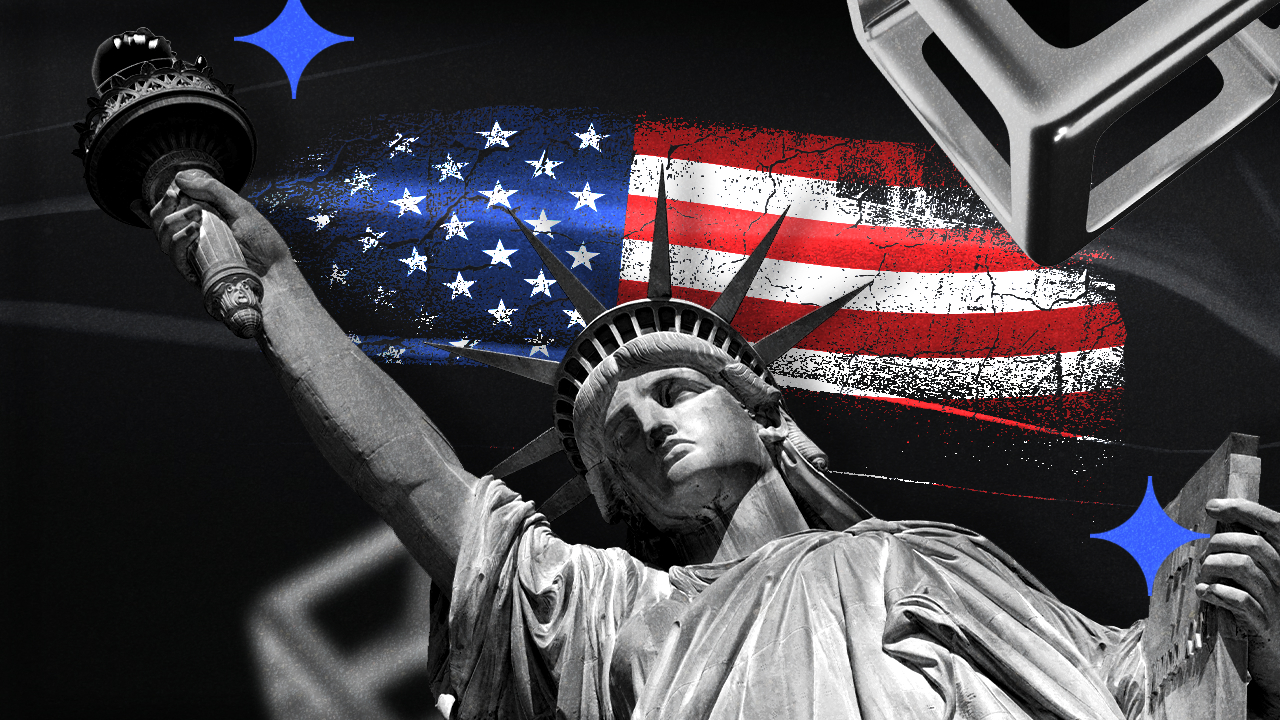
Welcome to the US Morning Crypto Briefing—your essential rundown of the most important developments in crypto for the day ahead.
Grab a coffee to see how Standard Chartered sees early signs of institutional investors turning to Bitcoin as a hedge against equity market volatility, just as traders gear up for a potentially volatile week driven by tariff news. At the same time, Coinbase wraps up its worst quarter since the FTX collapse, and U.S. regulators inch closer to unified stablecoin legislation.
Standard Chartered Sees Signs of Bitcoin Starting to Be Used as Hedge Against Market Volatility
Geoff Kendrick, Head of Digital Assets Research at Standard Chartered, sees signs that institutional traders are starting to use Bitcoin as a hedge against equity market volatility.
In a recent exclusive interview with BeInCrypto, Kendrick highlighted that this trend is already underway, with investors seeking alternatives to traditional instruments. “This is happening already,” Kendrick stated. “Investors used to use FX, specifically AUD, for this purpose due to its highly liquid and positive correlation to stocks, but now I think Bitcoin is being used because it is also highly liquid and trades 24/7.”
Additionally, in an investor note from late March, Kendrick expanded on Bitcoin’s evolving role in investment portfolios, suggesting that over time, Bitcoin may serve multiple purposes—both as a hedge against traditional financial market fluctuations and as a proxy for tech stocks.
He pointed out signs that markets could anticipating a less severe tariff announcement from the U.S. on April 2. “Given this has been the worst quarter for the Nasdaq since Q2 2022, there should be a degree of portfolio rebalancing (buying) that needs to take place,” Kendrick added.
As of April 1, 2025, Bitcoin has shown resilience amid broader market uncertainties. The cryptocurrency is up approximately 3.32%, trading at $84,282. This uptick comes alongside an overall increase in the global cryptocurrency market capitalization. In contrast, U.S. stock futures, including Dow Futures, S&P 500 Futures, and Nasdaq Futures, are all trending lower in pre-market trading, reflecting investor caution ahead of the anticipated tariff announcements.
Bitcoin Options Heat Up Before Trump’s “Liberation Day”
FalconXCrypto Global Co-Head of Markets, Joshua Lim, noted that in anticipation of Wednesday’s Trump-tariff “Liberation Day,” crypto funds are actively purchasing Bitcoin options at two key strike prices: $75,000 on the downside to hedge against potential losses and $90,000 on the upside to capitalize on a price surge.
Lim highlighted that the options market is pricing in a potential 4% move in Bitcoin’s price during the event. “The implied event move embedded in Bitcoin options is around 4% for the 2 April event,” he told BeInCrypto.
He also pointed out that traders are likely to keep buying put options in the short term as a protective measure, maintaining a high options cost premium. “We believe the front of the options curve will hold its premium as traders continue to hedge their portfolios or replace spot positions with limited-loss option positions,” Lim added.
Additionally, he noted a 4-point increase in the VIX, signaling that investors expect heightened volatility in the coming days and are turning to options to manage risk or capitalize on price swings. “US equities are also showing a bid in options, with the front-month VIX up 4 points to 22v from last week,” he said.
Crypto Stocks Slide: Coinbase Suffers Worst Quarter Since FTX Collapse
Coinbase is closing out its roughest quarter since the FTX collapse, with its stock tumbling over 30% since January. While it dipped nearly 1% in early U.S. pre-market trading on Monday, the stock managed to claw back losses and is now up around 1%.
Other crypto-linked companies are also feeling the pressure. Galaxy Digital Holdings has dropped over 8% in pre-market trading, while mining firms Riot Platforms and Core Scientific are only barely staying afloat, each gaining less than 0.5%.
Meanwhile, CoreWeave, which pivoted from Bitcoin mining to AI infrastructure, is struggling after a disappointing IPO. Initially aiming for a $2.7 billion raise, the company had to settle for $1.5 billion, slashing its offer price from the $47–55 range to $40 per share. Since going public last Friday, its shares are down 6.8%, with a 7.3% drop recorded in the last 24 hours.
Byte-Sized Alpha
– Today’s JOLTS report, a key gauge of U.S. job openings, could sway Bitcoin—strong data may boost the dollar and hurt crypto, while a sharp decline could fuel rate-cut hopes and lift risk assets.
– Bitcoin is off to its worst quarterly start since 2018, dropping nearly 12% in Q1 2025—but growing whale accumulation, falling exchange supply, and signs of consolidation hint at a potential rebound ahead.
– Crypto scams are on the rise, with fake Gemini bankruptcy emails and a Coinbase employee breach fueling phishing attacks
– OKX has appointed former NYDFS Superintendent Linda Lacewell as Chief Legal Officer, a move aimed at bolstering its regulatory credibility as the exchange accelerates global expansion into regions like Europe and the UAE.
– A unified U.S. stablecoin regulation could soon become reality, as the STABLE and GENIUS Acts differ by only 20% and enjoy strong bipartisan support alongside SEC and CFTC involvement.
– A push for expanded crypto oversight is underway as incoming CFTC Chair Brian Quintenz meets with Senator Chuck Grassley to discuss regulating the crypto spot market.
Disclaimer
In line with the Trust Project guidelines, this price analysis article is for informational purposes only and should not be considered financial or investment advice. BeInCrypto is committed to accurate, unbiased reporting, but market conditions are subject to change without notice. Always conduct your own research and consult with a professional before making any financial decisions. Please note that our Terms and Conditions, Privacy Policy, and Disclaimers have been updated.
Market
SUI Price Stalls After Major $147 Million Token Unlock

SUI enters a critical phase today as a $147 million token unlock threatens to inject selling pressure into a market already testing key resistance levels. Despite a sharp rebound in momentum—evident in the RSI’s surge from oversold territory—SUI failed to break above the crucial 60 mark, signaling buyer hesitation.
The Ichimoku Cloud shows price action pressing against the cloud’s edge, but lacking the conviction needed for a clear breakout. With a possible golden cross forming on the EMA lines, bulls still have a chance—if they can overcome resistance at $2.50 and avoid being dragged down by post-unlock volatility.
SUI RSI Surged Since Yesterday But Failed To Break Above 60
SUI’s Relative Strength Index (RSI) has jumped sharply to 58.94, up from 29.38 just a day ago, reflecting a strong shift in short-term momentum.
The RSI is a momentum oscillator that measures the speed and magnitude of recent price changes. It typically ranges from 0 to 100. Readings below 30 suggest an asset may be oversold, while levels above 70 indicate it may be overbought.
The rapid rise in SUI’s RSI suggests buyers have stepped in aggressively after a period of heavy selling.

However, despite the impressive rebound, SUI’s RSI briefly approached but failed to break above the 60 threshold earlier today.
This level often acts as a short-term resistance during recovery phases, and the rejection may indicate lingering hesitation among buyers or profit-taking after the surge.
While the RSI nearing 60 is encouraging, a decisive move above it would be needed to confirm a breakout. For now, SUI appears to be in a recovery mode. However, the inability to push past 60 highlights that bulls are not fully in control just yet.
Ichimoku Cloud Shows Lack Of Strong Upward Momentum
SUI blockchain Ichimoku Cloud chart shows a potential breakout attempt, as the price has surged upward and is now hovering right at the edge of the Kumo (cloud).
This movement suggests bullish momentum is trying to build. However, the resistance provided by the thick, red cloud ahead could make it difficult for SUI to sustain the uptrend without stronger confirmation.
The Tenkan-sen (blue line) is starting to rise and has crossed above the Kijun-sen (red line), which is a bullish signal. However, the price still needs to clearly break and hold above the cloud to flip the overall trend from bearish to bullish.
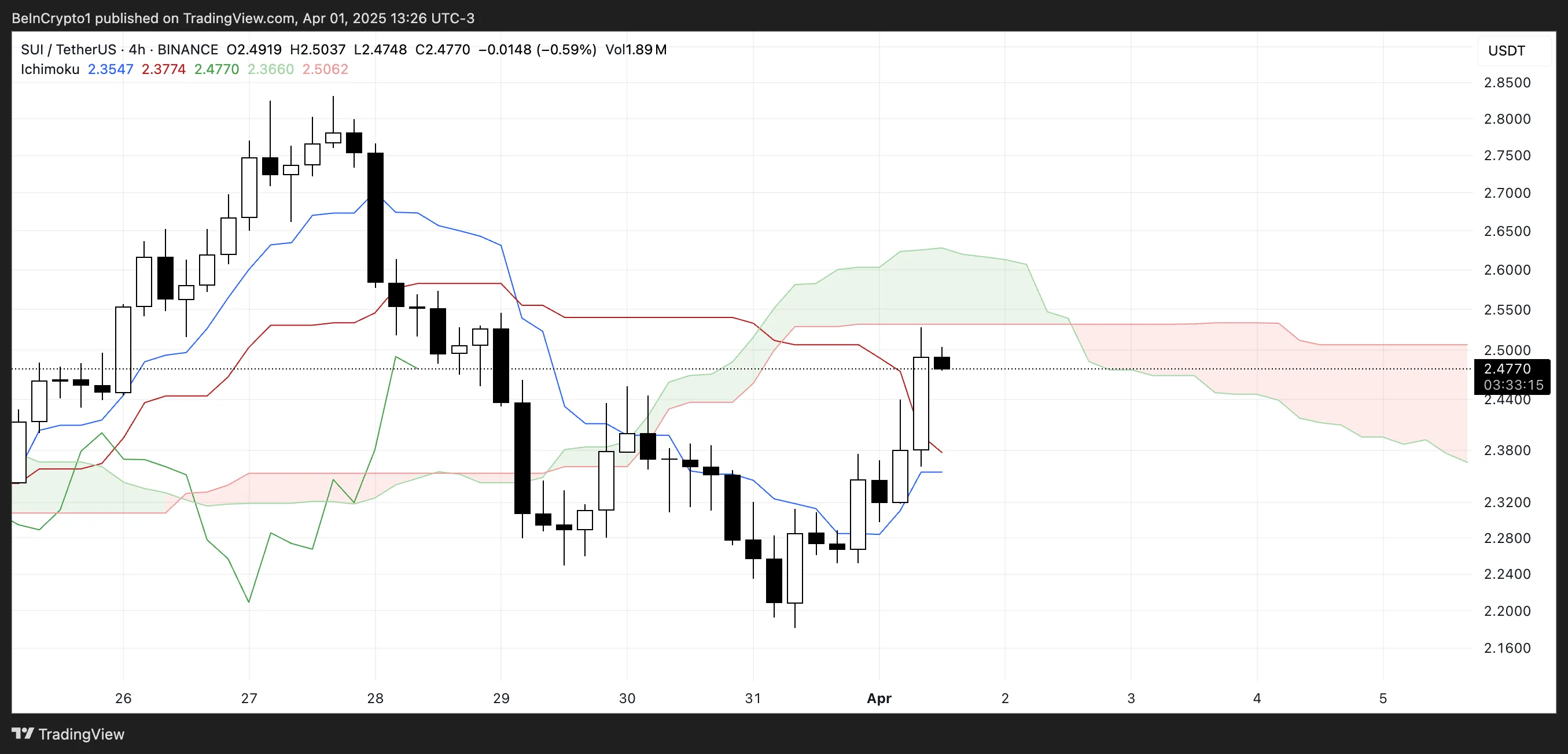
For now, the cloud remains bearish and flat, indicating possible resistance and a lack of strong upward conviction.
The current position suggests that SUI is at a key decision point—either break through the cloud to initiate a trend reversal or get rejected and slip back into the previous downtrend range.
If buyers can sustain the pressure and push the price above the upper cloud boundary, it could trigger a stronger rally. But without increased volume and broader market support, the price risks getting stuck in consolidation or turning back downward.
Will SUI Rise Back To $2.80?
SUI’s EMA lines are tightening and showing signs of a potential golden cross. That happens when a short-term moving average crosses above a longer-term one—a classic bullish signal that often precedes upward momentum.
However, the price is currently grappling with a key resistance near the $2.50 level.
If bulls manage to break through this level, it could open the path for a move toward $2.83.
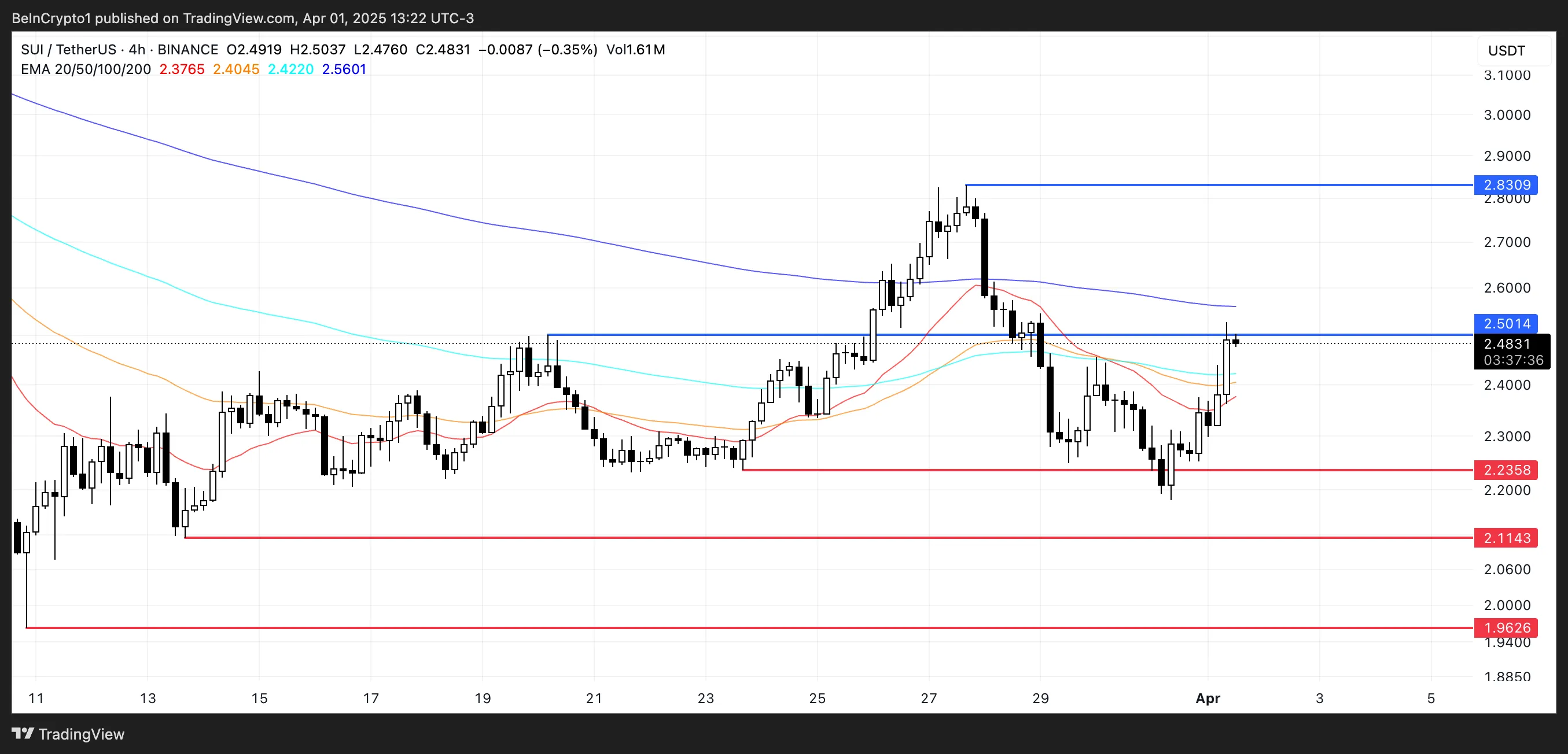
That said, downside risks remain, particularly with today’s $147 million token unlock, which could introduce significant selling pressure. If that selling materializes, SUI price could fall back to test the support at $2.23.
A breakdown below that level would likely shift momentum back in favor of bears. This would expose deeper supports at $2.11 and $1.96.
Disclaimer
In line with the Trust Project guidelines, this price analysis article is for informational purposes only and should not be considered financial or investment advice. BeInCrypto is committed to accurate, unbiased reporting, but market conditions are subject to change without notice. Always conduct your own research and consult with a professional before making any financial decisions. Please note that our Terms and Conditions, Privacy Policy, and Disclaimers have been updated.
Market
Circle Files for IPO


Leading stablecoin issuer Circle finally launched an IPO. It has been preparing for this launch for almost a year, and joins several other crypto firms that are interested in an IPO filing.
This gives Circle a number of opportunities, both to benefit financially and to better integrate with the financial infrastructure and regulatory apparatus.
Circle’s IPO Comes At Last
Circle, one of the world’s largest stablecoin issuers, just filed for an IPO. The firm has been planning this move for nearly a year, relocating to the United States to make the process easier. Since Trump won the most recent Presidential election, the firm’s chances of an IPO increased, and now it has finally pulled the trigger:
“For Circle, becoming a publicly traded corporation on the New York Stock Exchange is a continuation of our desire to operate with the greatest transparency and accountability possible. We are building what we believe to be critical infrastructure for the financial system, and we seek to work with leading companies and governments around the world in shaping and building this new internet financial system,” founder and CEO Jeremy Allaire claimed in the filing.
By launching this IPO, Circle has opened a few new doors for itself. Of course, it’s a substantial opportunity for revenue, but it’s also an important way to intensify the firm’s connections to the financial infrastructure. In this respect, it joins a number of other crypto firms that have sought their own IPO in the last month.
Circle’s IPO filing doesn’t list many concrete numbers, such as initial public offering price, number of available shares, proceeds to the selling stockholders, etc. However, this development is very recent. Further details will likely come to light as the sale progresses.
Disclaimer
In adherence to the Trust Project guidelines, BeInCrypto is committed to unbiased, transparent reporting. This news article aims to provide accurate, timely information. However, readers are advised to verify facts independently and consult with a professional before making any decisions based on this content. Please note that our Terms and Conditions, Privacy Policy, and Disclaimers have been updated.
-

 Market21 hours ago
Market21 hours agoEthereum Price Faces a Tough Test—Can It Clear the Hurdle?
-

 Bitcoin13 hours ago
Bitcoin13 hours ago$500 Trillion Bitcoin? Saylor’s Bold Prediction Shakes the Market!
-

 Market20 hours ago
Market20 hours agoSolana (SOL) Holds Steady After Decline—Breakout or More Downside?
-

 Ethereum19 hours ago
Ethereum19 hours ago$2,300 Emerges As The Most Crucial Resistance
-

 Market19 hours ago
Market19 hours agoCFTC’s Crypto Market Overhaul Under New Chair Brian Quintenz
-
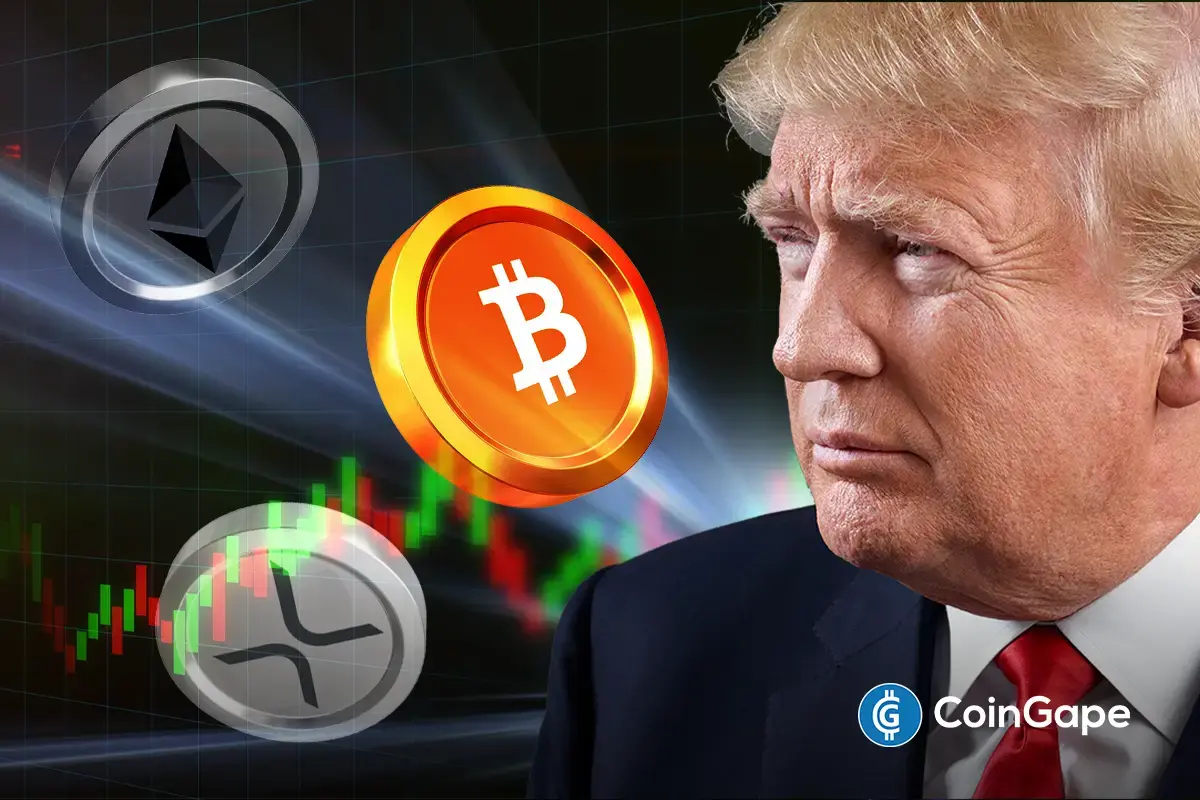
 Altcoin12 hours ago
Altcoin12 hours agoWill XRP, SOL, ADA Make the List?
-
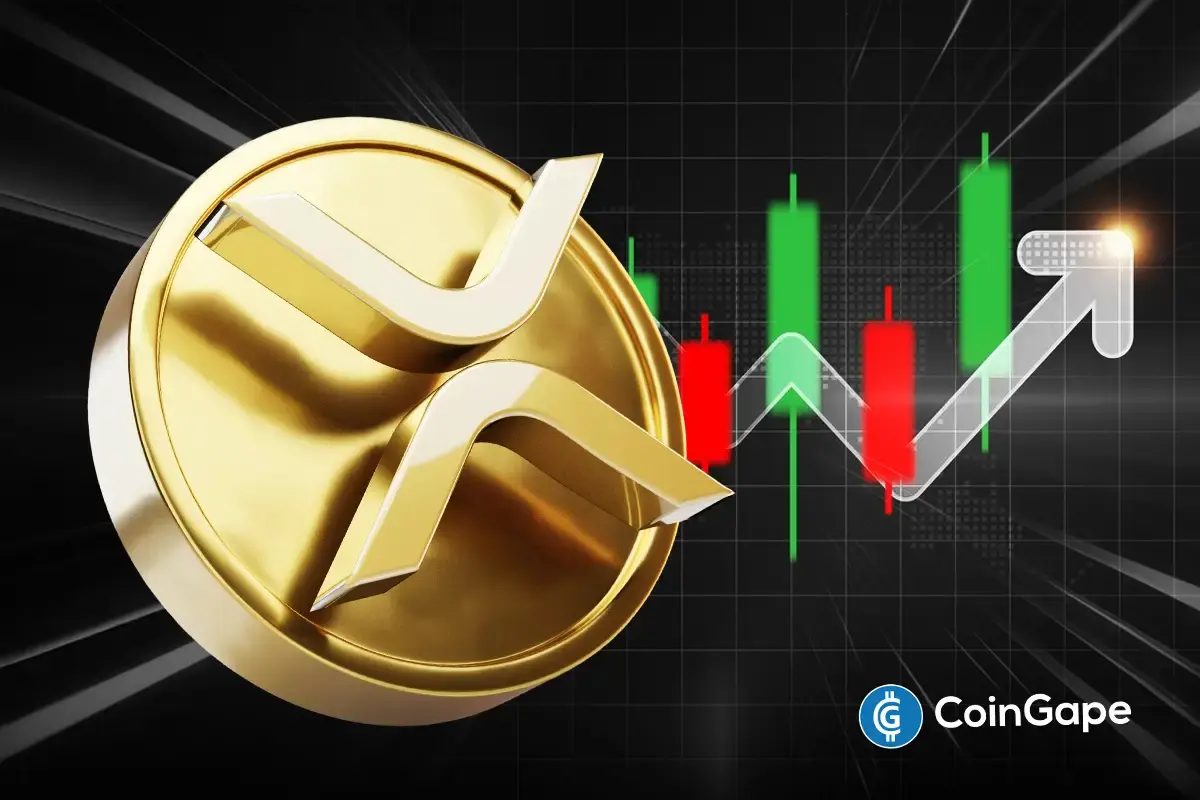
 Altcoin19 hours ago
Altcoin19 hours agoA Make or Break Situation As Ripple Crypto Flirts Around $2
-

 Market18 hours ago
Market18 hours agoXRP Bulls Fight Back—Is a Major Move Coming?








